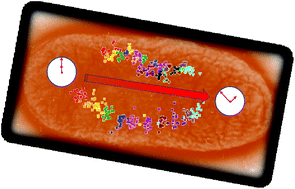Metabolism in action: stable isotope probing using vibrational spectroscopy and SIMS reveals kinetic and metabolic flux of key substrates†
Abstract
Microbial communities play essential functions which drive various ecosystems supporting animal and aquatic life. However, linking bacteria with specific metabolic functions is difficult, since microbial communities consist of numerous and phylogenetically diverse microbes. Stable isotope probing (SIP) combined with single-cell tools has emerged as a novel culture-independent strategy for unravelling microbial metabolic roles and intertwined interactions in complex communities. In this study, we applied Raman and Fourier-transform infrared (FT-IR) spectroscopies, secondary ion mass spectrometry (SIMS) with SIP to probe the rate of 13C incorporation in Escherichia coli at 37 and 25 °C. Our results indicate quantitative enrichment and flow of 13C into E. coli at various time points. Multivariate and univariate analyses of Raman and FT-IR data demonstrated distinctive 13C concentration-dependent trends that were due to vibrational bands shifting to lower frequencies and these shifts were a result of incubation time and metabolic rate. SIMS results were in complete agreement with the spectroscopy findings, and confirmed the detected levels of 13C incorporation into microbial biomass at the investigated conditions. Having established that FT-IR and Raman spectroscopy with SIP can measure metabolism kinetics in this simple system, we have applied the kinetics concept to study the metabolism of phenol by Pseudomonas putida and metabolic interactions within a two-species consortia with E. coli that could not degrade phenol. Raman spectroscopy combined with SIP identified quantitative shifts in P. putida due to temporal assimilation of phenol. Although E. coli was unable to grow on phenol, in co-culture with P. putida, general metabolic probing using deuterated water for SIP revealed that E. coli displayed increasing metabolic activity, presumably due to cross feeding from metabolites generated by P. putida. This study clearly demonstrates that Raman and FT-IR combined with SIP provide rapid and sensitive detection of carbon incorporation rates and microbial interactions. These novel findings may guide the identification of primary substrate consumers in complex microbial communities in situ, which is a key step towards the characterisation of novel genes, enzymes and metabolic flux analysis in microbial consortia.

- This article is part of the themed collection: 150th Anniversary Collection: Raman Spectroscopy and SERS


 Please wait while we load your content...
Please wait while we load your content...